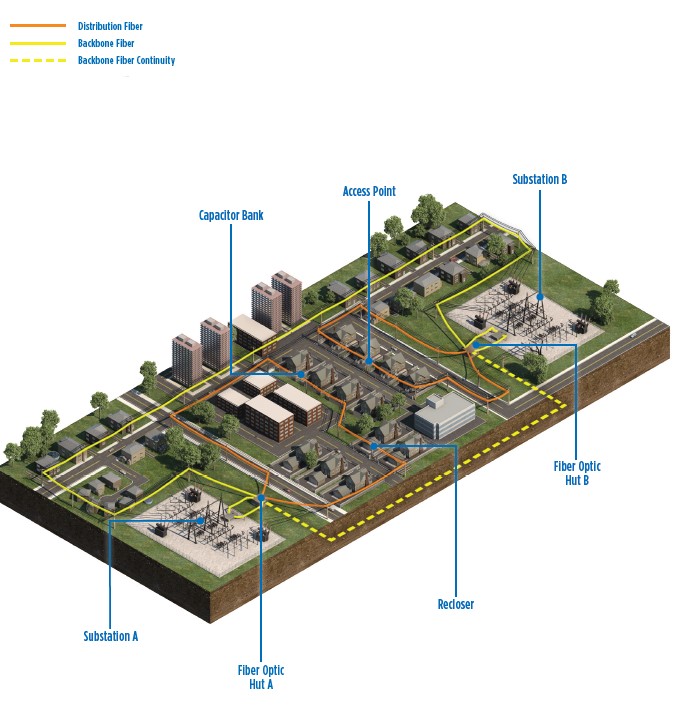How broadband communication networks can benefit power distribution
Distribution utilities looking for ways to squeeze more reliable, high-quality power from their electrical distribution infrastructure can now get their wish — while also delaying major capital expenditures, lowering their operating costs and improving their ability to integrate distributed energy resources.

By Joshua Smith and Bryan Knowles, PE, Burns & McDonnell
All are possible with the addition of dedicated broadband communication networks.
Adding intelligence to distribution networks, in fact, is the next logical step in the transformation to a more reliable, secure and energy-efficient power grid. Already implemented in many substations, embedded intelligence is becoming more economical and practical to implement in the last mile of distribution systems. In addition to gaining the operational advantages offered by embedded intelligence, distribution utilities also benefit from government incentives that reward these energy-saving investments.

Faster decisions, more efficient power
Electrical power demand fluctuates throughout the day. By analyzing electrical data at multiple points on the distribution feeder, utilities are now tracking these fluctuations and making real-time decisions that help the grid operate more efficiently.
As a consequence, the addition of new devices and technology on the grid is raising the bar on the performance needs of communication infrastructure for effective grid operation. Distribution automation, voltage optimization, system healing and recovery, and the prevalence of distributed energy resources have all fueled a need for timely data. A reliable, fast communication system is key to unlocking the full potential of these systems and the intelligent devices controlling them.
The bandwidth of the current wireless communication networks is not sufficient to support the next wave of distribution automation devices. Adequate support often requires third parties to aid radio backhauling, increasing operations and maintenance (O&M) costs. Leased lines, an aging technology no longer supported by telecom companies, are also unreliable with service-level agreements that are ordinarily outside of a utility’s control. Leased lines also have lower bandwidths and higher O&M costs.
In contrast, dedicated broadband networks can deliver the speed, security and reliability that the modern and future grid requires.
Because control decisions must be made quickly, fast and reliable communication is key to controlling a modern distribution system. Two technologies are being tapped to provide this broadband communication: fiber and LTE. Fiber delivers extremely high throughput, providing extra capacity for future use. Creating a fiber-rich network lays the groundwork for future distribution automation devices, advanced metering technology and the Internet of Things. When the cost of fiber becomes uneconomical, private LTE radio communications can be used to extend the broadband signal from a fiber-connected site out to each distribution pole.
Further, the addition of this communication infrastructure enables new intelligent devices on the distribution system to coordinate with each other and headend software. Redundant ring architecture is used to create two fiber paths to any device or substation, helping to maintain communication if a network is damaged, compromised or destroyed.
Amplifying the power of distribution automation
The value of a communication network is unleashed when sensors, meters and relays are added to the system to collect electrical distribution data that can then be integrated into distribution management systems.
Some intelligent devices sense changing operating conditions on the grid. Others detect failing devices or identify outages and their causes. Distribution automation, which digitizes this data, enables utilities to peer deep inside the grid and remotely monitor and control each asset from the substation to the consumer’s meter in real time. Computer algorithms automatically make adjustments that optimize energy distribution at each transfer point.
Consider voltage optimization programs, for example. Systems run more efficiently when they operate in the lower half of the ANSI C84.1 tolerance. By consistently operating systems at the lower end, utilities can reduce power demands on the system, thereby delaying major system upgrades. A communication network that relies on low-speed communication systems has limited ability to see that capacitor banks, voltage regulators and transformer load tap changers work together to maintain proper voltage. Often, the utility only gets this data every few hours, not often enough to optimize in real time. Utilizing a broadband network for these devices enables data collection in hundreds of milliseconds, letting the utility react to changes on the grid as they happen.
Similarly, with distribution automation, reclosers react to system faults to isolate problems while maintaining power to unaffected areas. A broadband network delivers the reliable communication required to see that the status of these devices is known and the utility is aware of outages. For example, reclosers compare the real-time state in tens of milliseconds and implement the recovery switching while the devices are operating. The customer experiences a flicker instead of an outage. Other electrical distribution data can likewise be used to maximize efficiency across the grid. Better management of energy use data and automatic restoration of power can also reduce outage times and improve power reliability.
Begin with low-hanging fruit
Communication networks deliver greater value in some places than others. The circuits that benefit most are those where fluctuation in demand is greatest.
Using voltage reduction and automatic load transfer schemes, broadband communication can enable a central controller to manage system configuration, operating each segment of the feeder closer to its design limit. The result is better utilization of the assets and deferred upgrade costs to increase the capacity of the feeder and eliminate a constraint that may only exist for a short period. With distributed energy resources being installed, a non-wires alternative enabled by communication is often more economical than a reconductoring project.
When implementing broadband networks to support distribution modernization initiatives, utilities often link their installation teams with the professionals in their distribution departments who are responsible for infrastructure maintenance needs. In addition to installing the new networks, these teams can be called upon to replace outdated or underperforming infrastructure along the route, particularly on poles that have already been inspected for structural integrity and tagged for replacement or repair. This can be a time- and cost-saving way to bring poles up to fiber clearance, insulation and other current standards.
Monetizing your fiber investment
The fiber cable used on a dedicated fiber network has a large capacity — often more than a utility may need for its own use currently.
Utilities that own their own poles can monetize this investment by leasing unused (dark) fiber to others. This leased fiber can offset future O&M costs as an additional source of income. Such long-term leases enable these utilities to recoup some of their installation and upkeep costs, while also helping to fund future investments. When combined with federal funding incentives, fiber infrastructure is becoming more affordable to install.
Just getting started
For electric utilities seeking new efficiencies in power distribution, broadband networks supported with a dense deployment of fiber show great promise to support distribution automation. The fast and reliable communication made possible by broadband can enable utilities to scale their communication and SCADA systems to monitor electrical distribution data across the grid.
Dedicated broadband networks have the potential to do much more.
They can help optimize asset utilization and operating efficiency. They make it possible for networks to ascertain power quality and react to power disturbances with a self-healing response. By understanding distribution configurations and automatically identifying outages, they can quickly shift loads on the grid distribution system and minimize downtime.
At a higher level, the asset data these devices collect can help optimize operational planning. In short, by modulating the distribution grid in real time as change happens, smart distribution networks make the grid stronger. For utilities seeking new efficiencies and improved energy reliability, their time has come.
Illustration credit : Banner and thumbnail by Denny Müller on Unsplash


